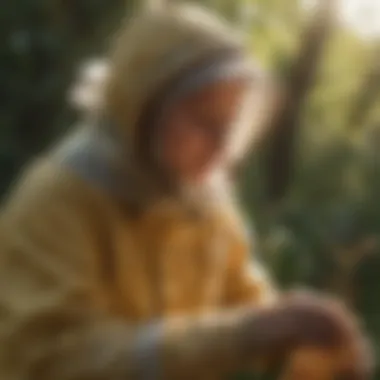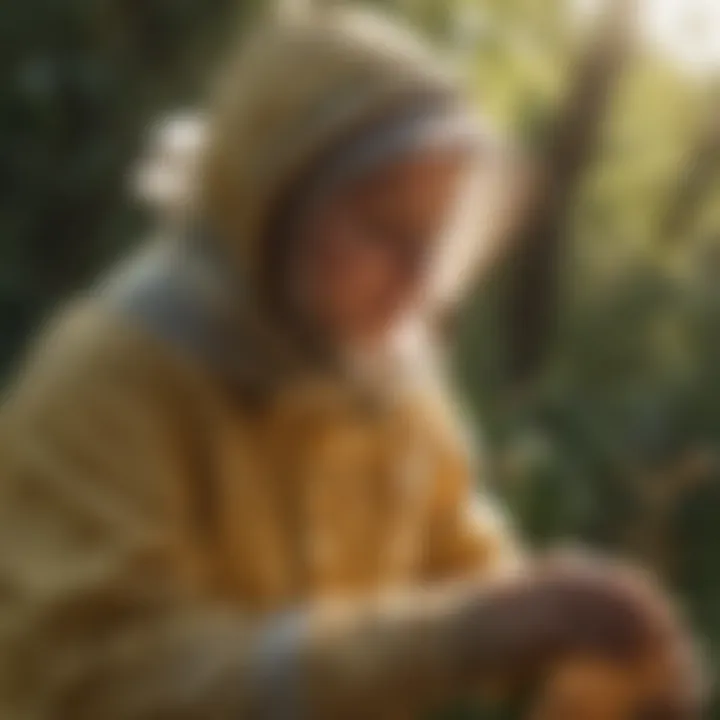Bee Responsible: Sustainable Pollination Practices


Intro
Bees are vital to our ecosystems and agriculture. They are key pollinators, ensuring the growth of many plants we rely on for food. Yet, bee populations face significant challenges today due to habitat loss, pesticide use, and climate change. These issues have made sustainable pollination practices more important than ever. Understanding the significance of responsible beekeeping practices can help mitigate these challenges and promote both agricultural productivity and environmental health.
Given the situation, it is crucial to redefine how farmers and beekeepers interact with bee populations. This article not only outlines effective strategies for sustainable beekeeping and pollination but also emphasizes the ecological importance of these practices.
As we navigate through this discourse, we will cover key concepts, recent trends, and practical applications in the field of sustainable pollination. Our goal is to equip farmers and enthusiasts with the knowledge they need to encourage healthy bee populations while maximizing their agricultural outputs.
Preamble to the Importance of Bees
Bees hold a pivotal role in ecosystems, making their preservation essential for environmental health and agricultural success. This section explores the necessity of bees as invaluable pollinators, emphasizing their contributions to biodiversity and food production. The intricate relationship between plants and bees not only sustains various species but also ensures food security for humans.
Ecological Role of Bees
Bees are integral to the process of pollination. They facilitate the reproduction of flowering plants by transferring pollen, which is crucial for seed and fruit formation. Over 75% of the world’s crops benefit from this natural service provided by bees. Without bees, many plants would struggle to reproduce, leading to a decline in plant diversity. This loss of biodiversity disrupts ecosystems and affects other species that rely on those plants for food and habitat.
Furthermore, the health of bee populations reflects the overall health of the environment. Healthy bee populations indicate that habitats are thriving, while their decline signals potential ecological issues. Protecting bee habitats can contribute to overall biodiversity, creating a more resilient environment against stressors like climate change.
Economic Impact of Bee Pollination
The economic implications of bee pollination are substantial. In the United States alone, bees substantially contribute an estimated $15 billion in crop value annually. Major crops such as almonds, apples, and blueberries rely heavily on bee pollination. The increase in yields and quality of these crops results in significant economic benefits for farmers and local economies.
On a broader scale, the decline of bee populations could lead to increased food prices and reduced supply, impacting consumers around the world. Farmers might resort to artificial pollination methods, which can be significantly more costly and labor-intensive. Therefore, it is not just an environmental issue but also a critical economic concern.
"The role of bees in agriculture is more than just pollination; it is essential for the economy and food security worldwide."
Promoting sustainable practices that support bee populations is, therefore, not only an ethical concern but also a necessity for ensuring long-term agricultural productivity and economic stability. Understanding their ecological and economic significance is key to advocating for responsible beekeeping and agricultural practices.
Challenges Facing Bee Populations
The decline of bee populations poses a significant threat to ecosystems and agriculture alike. As crucial pollinators, bees are integral to the reproduction of many plants, including those that humans rely on for food. Understanding the various challenges they face is essential in the quest for sustainable pollination practices. Addressing these issues can lead to improved outcomes for both agriculture and environmental health.
Pesticides and Chemical Exposure
Pesticides are among the most pressing threats to bee health worldwide. Chemicals used in farming to control pests often do not discriminate between harmful insects and beneficial ones. Neonicotinoids, for example, have been linked to increased bee mortality. Exposure can weaken bees' immune systems, disrupt their navigation abilities, and impair their reproductive functions. As a result, it is crucial for farmers to evaluate their pesticide use and opt for alternatives such as integrated pest management practices. Effective strategies might include the use of organic pesticides, which are less harmful, or introducing beneficial insects that target pests without endangering bees.
Habitat Loss and Fragmentation
The expansion of urban areas and intensive agriculture has led to significant habitat loss for bees. Natural habitats provide food and nesting sites, essential for bee survival. When these areas are cleared or fragmented, it creates isolated populations that struggle to thrive. Moreover, monoculture farming diminishes the diversity of flowering plants, which directly affects bees’ food availability. Promoting biodiversity in agriculture is critical. Planting diverse crops and maintaining wildflower strips can enhance the habitat for bees, supporting their populations.
Climate Change Effects
Climate change is another formidable obstacle for bee populations. Changes in temperature and weather patterns can disrupt the timing of flowering plants and the life cycles of bees. For instance, if flowers bloom earlier due to warmer temperatures, bees may not be able to synchronize their emergence, leading to food shortages. Additionally, extreme weather events—such as floods and droughts—can destroy habitat and create uninhabitable conditions for bees. Addressing climate change requires collaborative efforts to reduce carbon emissions and implement sustainable farming practices that can mitigate these effects.
"The health of bee populations is pivotal for food security and biological diversity."
In summary, tackling the challenges faced by bee populations is imperative for sustainable pollination practices. By understanding and mitigating issues such as pesticide exposure, habitat loss, and climate change, stakeholders can significantly contribute to the preservation and enhancement of bee health.
Responsible Beekeeping Practices
Responsible beekeeping practices are essential for ensuring the health and sustainability of bee populations. These practices not only enhance the productivity of apiaries but also contribute positively to the surrounding ecosystem. As the world becomes increasingly aware of the ecological and economic significance of bees, beekeepers are tasked with the responsibility to adopt methods that prioritize the welfare of their colonies and the environment.
By integrating sound management techniques, monitoring bee health, and implementing effective breeding strategies, beekeepers can mitigate some of the threats faced by bee populations. Alongside traditional beekeeping methods, these modern approaches can yield beneficial outcomes, not just for bees but also for agricultural practices and biodiversity as a whole.
Adopting Sustainable Management Techniques
Sustainable management techniques in beekeeping are vital for reducing stress on bee colonies. Practices such as organic farming, minimal intervention, and thoughtful hive placement can minimize the adverse effects of pesticides and environmental changes.


Beekeepers can utilize integrated pest management (IPM) strategies that combine biological, cultural, and mechanical controls. This reduces reliance on chemical pesticides, which are detrimental to bee health.
Incorporating forage sources within the vicinity of hives is beneficial. Diverse flowering plants enhance the nutrition of bees and improve their resilience. Moreover, rotating bee yards seasonally allows for better foraging opportunities and reduces the risk of disease transmission among colonies.
Health Monitoring of Bee Colonies
Regular health monitoring of bee colonies is crucial for identifying and addressing potential health issues before they escalate. Employing a systematic approach allows beekeepers to evaluate the health of their bees and the overall status of their colonies.
Key areas to focus on include:
- Regular inspections: Monitor for signs of disease, pest infestation, or nutritional deficiencies. Early detection is critical.
- Varroa mite control: This pest poses one of the most significant threats to honeybees. Beekeepers should regularly check for presence and implement control measures if necessary.
- Record-keeping: Keeping detailed records of treatments, inspections, and bee performance can guide future management decisions and improve overall strategies over time.
By maintaining a proactive approach to health monitoring, beekeepers create an environment where colonies can thrive, which in turn supports their role in regular agricultural practices.
Effective Breeding Strategies
Implementing effective breeding strategies can enhance the resilience and productivity of bee colonies. Selecting for desirable traits, such as gentleness, productivity, and disease resistance, is essential for the long-term sustainability of beekeeping.
Breeding programs that focus on local bee populations and their specific adaptations often yield better results. Different geographic areas have distinct environmental pressures which shape bee behavior and health.
Some strategies include:
- Artificial insemination: This controlled breeding method helps ensure the quality of queens, which is fundamental for strong colonies.
- Drone management: Healthy drones play a pivotal role in fertilizing queens. Managing drone populations strategically can improve mating success.
- Maintaining genetic diversity: Avoiding inbreeding by introducing new genetic stock from other regions can bolster the vigor and productivity of local bee populations.
By prioritizing responsible breeding practices, beekeepers can foster healthier colonies that contribute sustainably to pollination efforts and support agricultural needs.
Pollinator-Friendly Agricultural Practices
Pollinator-friendly agricultural practices represent a key component in promoting sustainable ecosystems. The relationship between agriculture and pollinators, especially bees, is symbiotic; while bees facilitate crop pollination, the diversity in crops contributes to the overall well-being of pollinator species. Implementing these practices is essential not only for biodiversity but also for agricultural productivity.
One significant element of pollinator-friendly practices is the integration of crop diversity and rotation. This approach minimizes monocultures, which can be detrimental to bee populations. A variety of flowering plants throughout the growing season ensures that bees have access to a continuous food source. In biologically rich landscapes, farmers can see enhanced plant health and yields due to more effective pollination.
Benefits of Crop Diversity and Rotation:
- Nutritional Variety: Different crops attract various pollinator species, allowing for a richer ecosystem.
- Soil Health: Rotating crops can improve soil structure and fertility, contributing indirectly to the health of pollinators.
- Pest Control: A diverse plant environment can deter pests naturally, reducing the need for chemical interventions that harm bees and other pollinators.
Crop Diversity and Rotation
Crop diversity and rotation are effective practices that serve to support bees right from the ground up. By planting different types of crops, farmers can avoid the pitfalls of single-crop farming which often leads to a lack of forage for bees. For instance, a field that alternates between legumes, grains, and sunflowers can maintain a steady supply of pollen and nectar for bees at various times of the year.
Moreover, the establishment of cover crops during fallow periods can greatly benefit pollinators. Plants such as clover or buckwheat not only provide forage but also improve soil health. This combination of environmental benefits leads to a more resilient ecosystem for both crops and pollinators.
Integrated Pest Management
Integrated pest management (IPM) is another essential component of an agricultural system supportive of pollinators. This strategy emphasizes the use of biological, cultural, and mechanical control methods before resorting to chemical methods. The goal is to manage pest populations below damaging levels while minimizing harm to beneficial insects like bees.
Adopting IPM practices means that farmers can assess pest threats and determine the best management practices for their specific situation. For example, introducing natural predators or using pheromone traps can effectively control pest populations while preserving the health of bee populations. This approach reduces chemical exposure and supports the overall ecological balance on farms.
"By aligning pest management with pollinator conservation efforts, we can create agricultural landscapes that are productive and sustainable."
Providing Habitat for Pollinators
Providing adequate habitat for pollinators is critical. Agricultural landscapes often lack natural spaces where bees can thrive. Farmers can take initiatives to include hedgerows, wildflower strips, and even maintain patches of native vegetation. These habitats not only offer refuge but also provide essential food sources for bees throughout their lifecycle.
In planting native flowering plants, farmers will financially benefit from improved pollinator activity which translates into better crop yields. Minimally disturbed zones adjacent to crop fields can create sanctuaries for bees. It is imperative to avoid excessive tillage or chemical treatments around these habitats, as they might disrupt bee populations.
Key Actions for Providing Habitat:


- Maintain Natural Vegetation: Allowing small areas of land to remain uncultivated can support bee populations.
- Plant Native Flowers: Focus on species that bloom at different times to ensure a consistent food supply for bees.
- Reduce Chemical Usage: Limiting pesticide use in and around pollinator habitats is essential for their survival and success.
The Role of Legislation and Policy
Legislation and policy play a critical role in shaping sustainable practices for beekeeping and pollination. The frameworks established by governments can help protect bee populations from threats that arise due to human activity. Effective legal measures are essential to minimize harmful practices while promoting conservation efforts. This section delves into the importance of regulations on pesticides and the support for pollinator conservation programs.
Regulations on Pesticides
Pesticide use is one of the most significant factors contributing to the decline of bee populations. Many pesticides are toxic to bees and disrupt their behavior, leading to decreased foraging efficiency and colony health. Regulatory measures aiming to control the use of harmful chemicals can greatly benefit both bees and agricultural productivity.
Some key aspects of pesticide regulations include:
- Banning harmful substances: Identifying and prohibiting the use of specific pesticides known to harm bees is crucial.
- Creating usage guidelines: Establish guidelines detailing when and how pesticides can be applied, especially in proximity to blooming plants.
- Promoting organic alternatives: Encouraging the use of organic pesticides can reduce chemical exposure and create safer environments for bees.
By implementing stricter regulations, governments can ensure a safer habitat for pollinators while benefiting agricultural systems. Research shows that integrated pest management (IPM) strategies often lead to healthier bee populations, resulting in better crop yields. The connection between bee health and agricultural resilience is strong.
"Protecting pollinators is essential for maintaining our ecosystems and food supply."
Support for Pollinator Conservation Programs
Support for pollinator conservation programs can lead to significant advancements in preserving bee populations and habitats. Governments and institutions must provide resources and funding for initiatives that promote sustainable beekeeping practices.
Some notable strategies include:
- Funding research initiatives: Financial support for research on pollinator health issues can help develop innovative solutions.
- Creating educational programs: Offering training for farmers and beekeepers can foster greater awareness of sustainable practices.
- Initiatives for habitat restoration: Funding for the creation and maintenance of pollinator-friendly habitats can improve biodiversity and support bee populations.
Investing in these programs not only enhances the population of bees but also solidifies the connection between farming and environmental stewardship. This effort ultimately leads to sustainable agricultural practices, benefitting both producers and consumers alike. By prioritizing biodiversity through intentional policy, we lay the groundwork for a healthier ecosystem.
Community Engagement and Education
Community engagement and education play a critical role in fostering sustainable practices in beekeeping and pollination management. Understanding the intricate relationship between bees and the ecosystem is vital not only for beekeepers but also for farmers, policymakers, and the general public. Through effective engagement, communities can work collaboratively towards enhanced awareness and action regarding bee preservation.
Educating the community about the importance of bees can lead to increased support for conservation efforts. It can promote healthier local environments that benefit both agriculture and native ecosystems. When individuals understand how bees contribute to food production and biodiversity, they are more likely to take sustainable actions in their daily lives.
Community programs that focus on bee awareness can also create a ripple effect. Local farmers may be inspired to implement practices that benefit pollinators, while consumers may choose to support bee-friendly products. Additionally, initiatives that bring together various stakeholders can lead to sharing best practices and innovative solutions to pressing challenges affecting bee populations.
Engagement should include practical workshops, talks, and interactive events that allow community members to ask questions and share ideas. It is important to address misconceptions about bees and beekeeping to encourage greater participation.
Raising awareness about the importance of bees can not only foster greater community involvement, but also significantly influence agricultural practices at the local level.
Raising Awareness of Bee Importance
Raising awareness of the significance of bees is crucial. Without proper visibility, the decline in bee populations may continue unnoticed. The consequences of this decline extend beyond the beekeeping industry; they impact food security and biodiversity. Educational campaign efforts can inform the community about how essential bees are for pollination, which in turn supports fruit, vegetable, and nut production.
Several strategies can enhance awareness:
- Workshops and Seminars: These are effective in sharing knowledge regarding bee biology and the challenges they face.
- Social Media Campaigns: Utilizing platforms like Facebook and Reddit can help disseminate information rapidly to a larger audience.
- Participatory Events: Beekeeping demonstrations allow participants to observe and engage directly, enriching their understanding and appreciation for bees.
By leveraging these tools, communities can create a culture that values and protects these vital pollinators. Schools and local organizations can collaborate to establish community gardens, incorporating pollinator-friendly plants to attract bees. Such initiatives not only beautify neighborhoods but serve as living classrooms for education about bees and their ecological contributions.
Incorporating Beekeeping into Educational Programs
Incorporating beekeeping into educational programs can serve multiple objectives. It can equip the next generation with knowledge about sustainable agriculture practices, nurturing environmental stewardship among young people. Schools can implement beekeeping as part of their science and agriculture curricula, fostering hands-on learning experiences.
Some methods to effectively integrate beekeeping include:
- Curricular Options: Develop courses that cover bee biology, ecology, and the impact of bees on food systems.
- Hands-On Beekeeping Clubs: These clubs give students practical experience in managing hives, understanding bee behavior, and conducting research.
- Field Trips: Visiting local farms or apiaries can provide real-world insight into sustainable beekeeping practices.


By bringing awareness and knowledge of beekeeping into schools and communities, we create advocates for bees and sustainable agricultural practices. The engagement in educational settings prepares future generations to appreciate and protect bee populations, ensuring that they continue to thrive. This creates a sustainable future for both agriculture and the environment.
Case Studies of Successful Practices
Understanding practical examples of how successful strategies can be implemented is essential for promoting sustainable pollination. These case studies provide tangible evidence of how local farms and innovative initiatives can integrate bee-friendly practices into their operations. They offer insights into the varying degrees of collaboration and commitment that lead to both environmental and economic benefits. These real-world examples can inspire others to adopt similar practices, fostering a collective move towards sustainability.
Local Farms Implementing Bee-Friendly Practices
Many local farms have recognized the importance of supporting bee populations. By adopting bee-friendly practices, they not only enhance the health of their ecosystems but also improve their crop yields. These farms often employ a variety of methods:
- Planting diverse crops: This increases the availability of food sources for bees throughout the growing season. Varieties of flowers and crops provide vital nectar and pollen.
- Minimizing pesticide use: Integrated Pest Management techniques help in reducing chemical usage, allowing for a safer environment for pollinators.
- Creating bee habitats: Establishing wildflower strips or hedgerows around fields can provide essential resting and foraging areas for bees.
For example, a vegetable farm in California saw a 20% increase in fruit set by introducing wildflower margins. Studies show that such local initiatives lead to a healthier bee population and ultimately contribute to greater food production.
Innovative Beekeeping Initiatives
Innovation plays a crucial role in the future of beekeeping. Some initiatives now leverage technology to enhance bee health and productivity.
- Smart hives: These hives are equipped with sensors that monitor temperature, humidity, and bee activity. Such data can lead to timely interventions when there is a sign of stress or disease within the colony.
- Crowdsourced data collection: Platforms allow beekeepers to share and analyze information about bee health and environmental conditions. This promotes collaboration and collective action on a larger scale.
- Urban beekeeping: Many cities are beginning to embrace urban beekeeping as a way to promote local biodiversity. Urban areas often have unique floral resources that can support bee populations.
"Innovative beekeeping practices are essential for adapting to the challenges faced by apiculture today, with technology paving the way for enhanced bee management."
These initiatives demonstrate that with commitment and creativity, tangible solutions can develop that address both bee health and agricultural productivity. Each case study sheds light on how to balance ecological sustainability with the demands of modern farming.
Future Directions for Sustainable Beekeeping
The sustainability of beekeeping is crucial for supporting bee populations and ensuring effective pollination in agriculture. Looking ahead, it is vital to consider future directions that can either enhance or undermine sustainability initiatives. Understanding this topic is essential because it aligns economic interests with environmental stewardship. Moreover, the survival of bee populations depends on our ability to innovate and adapt to changes in agricultural practices, climate, and global markets.
Research and Development Needs
To cultivate a sustainable future for beekeeping, focused research and development becomes essential. One important area lies in studying bee diseases and potential treatments. Current approaches must evolve as pathogens adapt. Another critical focus should be the investigation of plant-pollinator interactions. Understanding which plants better support bee health can guide farmers in crop selection.
There is also a need for studies that assess the impacts of various agricultural practices on bee fitness. These studies can foster the development of best practices that do not compromise pollinator health. Additionally, developing high-yielding crop varieties that require less pesticide can benefit both farmers and bees.
Potential for Technological Advances
Technological advances hold significant promise for the future of sustainable beekeeping. Innovations such as precision agriculture allow for more efficient pesticide application, reducing harm to bees. Drones can help monitor hive conditions remotely, alerting beekeepers to issues before they escalate. Furthermore, the incorporation of data analytics helps manage bee colonies effectively by providing insights into bee behavior and health metrics.
With the rise of urban beekeeping, tools that facilitate hive management in urban settings can help bridge gaps between agricultural landscapes and city environments. Mobile applications aimed at beekeepers can streamline communication about best practices and resources.
Investing in research and technology not only promotes healthier ecosystems but also supports economic viability for farmers.
In summary, examining future directions for sustainable beekeeping presents crucial opportunities. Emphasizing research, innovation, and technology can foster practices that genuinely support both ecological balance and agricultural demands.
Epilogue
The conclusion of this article is pivotal, as it encapsulates the essence of sustainable beekeeping and pollination practices. Addressing this topic emphasizes the need for comprehensive understanding and action towards the preservation of bee populations, which are crucial for both ecological balance and agricultural productivity.
Summarizing Best Practices
A strong emphasis on best practices is vital for stakeholders involved in beekeeping and agriculture. These practices are founded on principles that prioritize the health and sustainability of bee populations. Key takeaways include:
- Diversified Planting: Farmers should grow a variety of plants that bloom at different times to provide a continuous food source for bees.
- Organic Farming: By avoiding harmful pesticides, farmers can create a safer environment for bees. This includes the use of organic substitutes that minimize chemical exposure.
- Creating Habitats: Establishing buffer zones with wildflowers can increase bee habitats, allowing pollinators to thrive in agricultural areas.
Best practices also require continuous education and adaptation as new research emerges. Stakeholders must remain proactive in understanding the developments in bee health and ecology.
Call to Action for Stakeholders
A call to action is critical for engaging farmers, beekeepers, policymakers, and researchers. Each stakeholder has a role in fostering a better environment for bees.
- Farmers can adopt sustainable practices as detailed above, transforming their methods to not only benefit their crops but also support pollinator health.
- Beekeepers must focus on the broader implications of their work, aligning their practices with ecological stewardship.
- Policymakers have the responsibility to enact and enforce regulations that protect bee habitats and restrict harmful pesticides.
- Researchers should continue to explore innovative solutions and technologies that enhance bee health and efficiency in pollination.
It is essential for all involved to collaborate and share knowledge, addressing the challenges that threaten bee populations. The well-being of bees translates directly to the health of our ecosystems and, ultimately, the productivity of our agricultural systems. Together, the collective commitment to responsibility and sustainability will sustain bees, our planet, and future generations.















